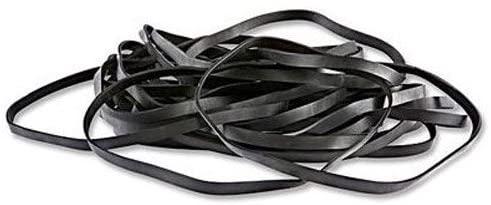Conductive rubber
Principle of electromagnetic shielding
1. When the conductive particles filled in the conductive rubber are filled with a certain volume, they will contact each other to form an electronic continuous state. When the external electromagnetic field reaches the outside of the conductive rubber, Strong electromagnetic waves hit the free electrons of the conductive particles, and the free electrons move freely. The free electrons form an electromagnetic field opposite to the external electromagnetic field during the movement. The internal and external electromagnetic fields cancel each other out to weaken the electromagnetic interference wave;
2. Another principle is energy conversion, the law of conservation of energy, electromagnetic waves hit free electrons. During the movement of free electrons, conductive particles have a certain resistance and generate heat, that is, electromagnetic interference waves-kinetic energy of free electrons-heat energy , To weaken electromagnetic interference waves.
According to the relationship between current, voltage and resistance, as long as there is a voltage drop, there will always be a certain amount of current flowing, but the current is too small to be felt. The volume resistance of conductive rubber is still very large relative to metal. According to the relationship between volume resistance and distance, the longer the distance, the greater the resistance. In medical electrodes, conductive rubber has been widely used. At this time, the conductive rubber electrode is relatively thin, generally below 1mm, and the electrodes are only in contact with the upper and lower surfaces, that is, the distance is only 1mm. At this time, the conductive rubber is fully energized.
Conductive rubber (15 sheets)
Structural design
Conductive rubber must be subjected to a certain compression force to conduct good conduction Therefore, the structural design must ensure that the appropriate pressure is not overpressured. The optimal height compression of the plate is 7-15%; the best height compression of solid round and D-shape is 12-30%; the best height compression of tubular and P-shape is 20-60%.
Purpose
The conductive rubber has good electromagnetic sealing and water vapor sealing capabilities, and can provide good conductivity under a certain pressure (the suppression frequency reaches 40GHz).
Conductive rubber meets the US military standard MIL-G-83528 and is widely used in the fields of electronics, telecommunications, electric power, military industry, aviation, aerospace, and ships. Conductive rubber is mainly made of high-performance silicon rubber as the base material, with special fillers (such as copper-plated silver, aluminum-plated silver, glass-plated silver, graphite nickel-plated particles, etc.) and additives, and are manufactured through a strictly controlled process. The volume resistivity can reach 0.004 ohm centimeter, and the stability is good.
Application
Conductive rubber usually means that the volume resistance is less than 10 to 9 ohm centimeters. Because rubber is an excellent insulator, the volume resistance is about 14 times greater than 10. Conductive rubber is divided into anti-static grade conductive rubber, the volume resistance is between 10 5 times to 10 9th power, conductive carbon black filled conductive rubber, the volume resistance can usually be maintained at a few thousand ohms, or even lower to one or two One hundred ohms, even lower than 50 ohm cm is already very difficult. When the volume resistance is less than 10 ohm cm, the conductive rubber has electromagnetic shielding function. The following is that the volume resistance is below 10 ohm cm, which is mainly used for electromagnetic shielding occasions, but also for electronic and microwave waveguide systems such as chassis, cabinets, shelters, and connector gaskets.
Optional
In our daily life, we can cut out a small piece of conductive rubber to repair the position of the electrical contacts like the remote control, for the battery electrode of the remote control. The iron sheet is relatively easy to be corroded. If you use a conductive rubber sheet to replace the electrode, it will not rust, it can be waterproof, and it is easy to replace, which is a good choice. However, conductive rubber filled with conductive carbon black can be used in daily life with a volume resistance in the range of several hundred ohm centimeters.
Whether the electromagnetic shielding effectiveness and the volume resistance must be proportional, that is, the better the conductivity, the higher the shielding effectiveness. According to the research of foreign scholars, there are three ways to weaken the interference wave: shielding, wave absorption and Filtering. Conductive rubber, due to its conductive particles, can produce a magnetic field opposite to the outside world during the movement of electrons, which acts as a shield. But the principle of wave absorption is similar to that of shielding, and microscopic particles are also used. When the filled conductive particles reach the nanometer level, not only the particle size is nm, but more importantly, they have a higher specific surface area and porosity. Such nanoparticles will have a better nano effect, and the nano effect can be absorbed. Wave action. It is the conductive rubber filled with conductive particles, which can play the role of shielding and wave absorbing. The volume resistance may only reflect the size of the shield from a certain side, but it cannot measure the size of the wave absorbing ability. Although conductive rubber filled with conductive carbon black has a large volume resistance, it can have a wave absorbing function due to its nanometer particle size and nanometer effect. Therefore, we will also see carbon black filled rubber as sealing strips on microwave ovens. The magnetic field strength of microwave ovens is particularly high, as high as 14G, and carbon black filled rubber can better weaken the magnetic field wave.
Case
Nickel-coated copper powder
Nickel-coated copper powder is the most ideal conductive filler for conductive silicone rubber, with excellent conductivity and electromagnetic wave shielding performance. When conductive rubber is formed at high temperature, it has good oxidation resistance, strong corrosion resistance in various environments (salt spray test) and a fairly long service life, which guarantees a 100% pass rate of the product. Compared with silver-plated products in terms of cost, such as silver-plated glass beads, silver-plated aluminum powder, silver-plated copper powder and pure silver powder, it has a strong cost advantage. The supply price will not be unstable due to the increase in silver price. Nickel-coated copper powder has comparable supply price stability and performance. It is the leading filler powder for conductive silicone rubber in the future. The main representative models in the market are Tengfei Metal Technology W-5 nickel-clad copper powder. Because the technology is relatively mature and the coating is good, it can be filled and used in various rubbers. From a technical point of view: a good nickel-coated copper powder has many technical difficulties in the production technology, and the coating is not good enough. Shielding performance requirements. Choosing a good nickel-coated copper powder is the key to product quality.
Aluminum silver-plated conductive rubber: has excellent shielding performance and anti-smoke performance;
Copper silver-plated conductive rubber: has the best electrical conductivity;
Silver-plated glass conductive rubber: has the best cost performance;
Pure silver conductive rubber: has good anti-fungal properties.
FIP conductive rubber
FIP (Form-In-Place) conductive rubber is a new type of high-performance electromagnetic Shielding composite materials, in the electromagnetic shielding material industry, are usually called dispensing conductive rubber. This material is specially designed to be in a fluid state and is made by uniformly mixing one-component or two-component silicone rubber and metal-based conductive fillers.
FIP, also known as dispensing forming, on-site forming, in-situ forming, in-situ forming, surface dispensing and surface dripping, refers to the forming method of conductive rubber.
When in use, use a computer-operated numerical control machine tool to apply air pressure to the uncured conductive rubber in a fluid state and apply it from the needle to the specified position on the flange surface. The spotted rubber does not flow or deform, and can be formed in situ at room temperature when exposed to moisture in the air. After curing, it will form a permanent bond with the substrate.
The main function of FIP conductive rubber is to provide low-impedance and flexible connections between conductive surfaces, and to provide environmental sealing, which can be used directly on the parts to be shielded. Because of its good thixotropy and adhesion, it can be directly applied to the flange surface made of a variety of metalized plastics and metal materials.
Project | Conductive filler | < td width="100"> | |||||
Silver | Nickel-Copper | Silver-Nickel | Silver-Aluminum | Silver-Glass | Silver Copper clad | Carbon black | |
Shore Type A hardness/degree | 65±5 | 5±5 | 75±5 | 65±5 | 65±5 | 65±10 | 65±7 |
Stretch Strength/MPa | ≥2.07 | ≥1.38 < /td> | ≥1.38 | ≥1.38 | ≥1.03 | ≥1.38 | ≥3.80 | Elongation at break/% | ≥200 | < td width="100">≥100 | < p>>100 | ≥75 | ≥100 | >100 |
Compression set (70 h×l00℃)/% | ≤45 | ≤32< /p> | ≤32 | ≤32 | < td width="100">≤30 | < p>≤45 | |
Maximum operating temperature/℃ | 160/200 | 125 | 125 | 160/200 | 160 | 150 | 200 |
Conductivity and electrical stability/(Ω·cm) | ≤0.002 | ≤0.004 | ≤0.005 | ≤0.008 | ≤0.009 | ≤0.1 | ≤8.0 |
Shielding effectiveness/dB | |||||||
≥200 kHz( Magnetic field) | 70 | 70 | 70 | 60 | 70 | NA | - |
100 MHz (electric field) | 120 | 120 | 120 | < p>115 | 120 | 100 | 80 |
500 MHz (electric field) td> | 120 | 120 | 120 | 110 | 120 | 100 | 80 td> |
2 GHz (plane wave) | 120 < /td> | 120 | 115 | 105 | 120 | 100 < /td> | 60 |
10 GHz (plane wave) | 120 | 120 | 110 | 100 | 120 | 100 | 50 |
Comparison of performance characteristics | |||||||
Shielding effectiveness | Excellent | Good | Good | Good | Medium | Medium< /p> | Poor |
Cost | Highest | Higher | High | High | Medium | p>low | lowest |
Corrosion resistance | Excellent grade | Poor | Good | Excellent | p>Good | Medium | Poor |

Latest: Easy Disk
Next: Ideal state








